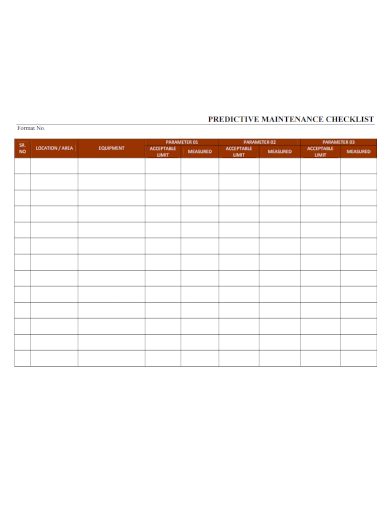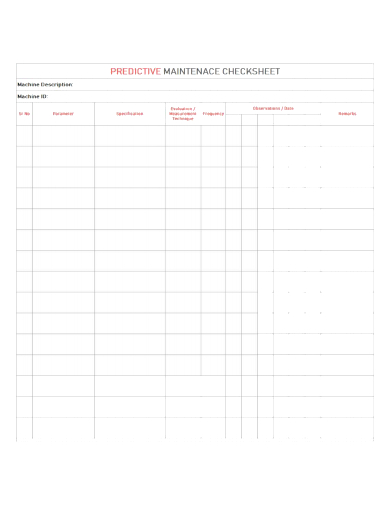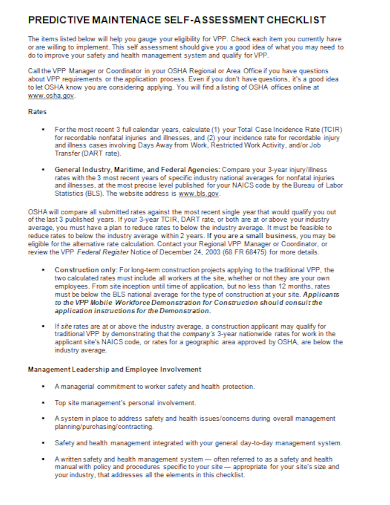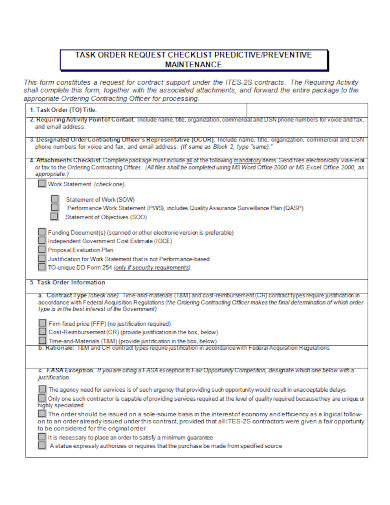Every workplace that uses heavy machines, equipment, and tools knows that to maintain their operations regularly to reach a certain mark of productivity, those items must be in great condition always. If the breakdown or get damaged, it costs the workplace valuable resources such as time and money to focus on repairing and replacing these parts and it will affect their production negatively. So these workplaces must make sure all these machines and equipment are always working properly. To do that, they need to have predictive maintenance that assesses their operations and alerts the workers when the machine has problems. A checklist can help workplaces remind them of the full maintenance process and tasks. Read the article to know how to create a predictive maintenance checklist.
3+ Predictive Maintenance Checklist Samples
1. Predictive Maintenance Checklist
2. Machine Predictive Maintenance Checklist
3. Predictive Maintenace Self Assessment Checklist
4. Predictive Preventive Maintenace Checklist
What is Predictive Maintenance?
Predictive maintenance is a planned procedure to keep all machines, equipment, and tools in the workplace always run smoothly. This type of maintenance is usually performed when the machines and equipment are running in production mode. It directly monitors their condition and performance to reduce the likelihood of unplanned breakdowns and reduce doing preventive maintenance by tracking failure and repairs to help predict problems that may occur in the future.
Details to Include in a Predictive Maintenance Checklist
Using a writing instrument and a sheet of paper, create a rough draft of the checklist for your predictive maintenance procedure. List down every maintenance task you need to do in every aspect of your workplace. To guide you, below are sample maintenance tasks to do for predictive maintenance:
1. General Safety
- Inspect personal protection equipment (PPEs) and replace anything worn or damaged
- First aid kits are properly stored and must have enough stock for everyone
- Check and restock all wash stations items and fall protection kits
2. Equipment and Machines
- Machines and equipment should be clear of debris. Wipe them away using lubricant or cleaning solution
- Inspect tools regularly to check for wear
- Check all machinery fluid levels and air filters regularly and replace them as needed
- Calibrate machines and check and maintain machine belts, motors, and power sources regularly
3. Facilities
- There should be enough space gap between equipment
- Safety and caution areas must have visible signs around them
- Walkways and other traffic areas should always be clear of debris and other material
- Wires are properly kept and secured
- Stairways and walkways must be in good condition and no items should be placed to obstruct the way.
- Regularly inspect structural building elements
- Check and repair building systems such as electrical, fire, plumbing, and network. Ensure you remain in compliance with government regulations.
- Check external facilities for hazards
- Don’t forget to check your roof
4. Vehicles
- Fuel levels should be checked regularly
- Car safety items should be working properly
- Inspect car parts to see if any of them need to be changed if necessary
- Ensure your insurance for vehicle accidents is up to date
FAQs
How do you do predictive maintenance?
Here is a rundown on how to do predictive maintenance:
- Know your reasons: Know what you want to upgrade in your maintenance practices. Do you want to address production efficiency? Reduce downtime? Improve equipment effectiveness? Whichever it is, you need to establish your reasons so you can use it as the main groundwork to invest your maintenance budget in.
- Evaluate your current maintenance status: Go around and assess your workplace and all the machines and equipment you use. Benchmark metrics of these objects such as uptime, quality, and machine performance. From your identified reasons, use those to know which areas you want to focus on improving in each object.
- Set targets: Set short and long-term goals of improvement that you want to see from predictive maintenance. This will be your basis on what tasks to do to achieve that goal.
- Evaluate your maintenance: Once you get going doing the predictive maintenance, you can gather data from it and assess if you need to invest in new technology that upgrades your machine to know whenever a problem occurs or not. This will greatly improve your maintenance process.
What are the examples of predictive maintenance?
Some examples of when predictive maintenance is used in refrigeration sensors and power outage sensors. Industries that could greatly benefit predictive maintenance are the oil and gas industry, building management, manufacturing monitoring, and aircraft maintenance.
What are the five types of maintenance?
The five types of maintenance are corrective, preventive, condition-based, predictive, and predetermined.
Once you’re done making the checklist, review it first with your employees. They might have suggestions to provide to improve the checklist better. Furthermore, discuss the tasks to be done and who will be responsible for carrying them out. Everyone must remember their tasks and do their best to regularly do their own maintenance task to ensure better productivity in machine and equipment operations. If you need further help in creating a predictive maintenance checklist, download the free sample templates provided above!
Related Posts
FREE 18+ Complaint Checklist Samples in MS Word | Google Sheets | PDF
FREE 18+ Internship Checklist Samples in MS Word | Google Docs | PDF
FREE 18+ Statement Checklist Samples in MS Word | Google Sheets | PDF
FREE 20+ Voluntary Checklist Samples in MS Word | Google Sheets | PDF
FREE 18+ Summary Checklist Samples in MS Word | Google Sheets | PDF
FREE 14+ Sponsorship Checklist Samples in MS Word | MS Excel | PDF
FREE 18+ Conference Checklist Samples in MS Word | Google Sheets | PDF
FREE 17+ Lesson Checklist Samples in MS Word | Google Sheets | PDF
FREE 18+ Progress Checklist Samples in MS Word | Google Docs | PDF
FREE 18+ Enrollment Checklist Samples in MS Word | Google Docs | PDF
FREE 18+ Graduation Checklist Samples in MS Word | Google Sheets | PDF
FREE 15+ Consent Checklist Samples in MS Word | Google Sheets | PDF
FREE 18+ Review Checklist Samples in MS Word | Apple Pages | PDF
FREE 18+ Submission Checklist Samples in MS Word | Google Docs | PDF
FREE 18+ Request Checklist Samples in MS Word | MS Excel | PDF




